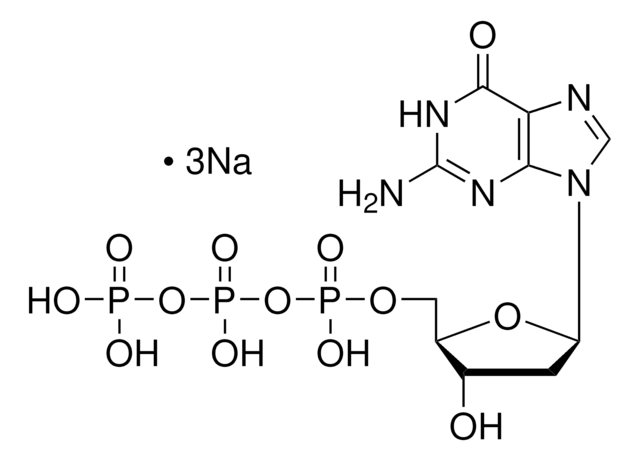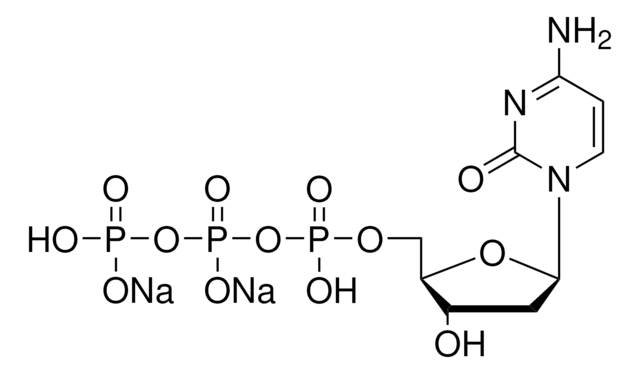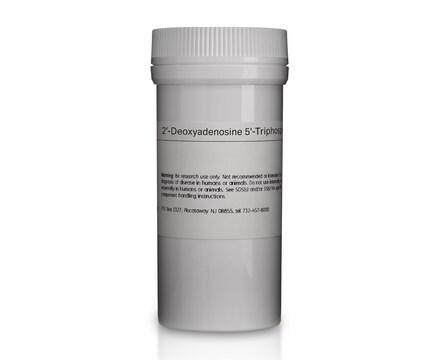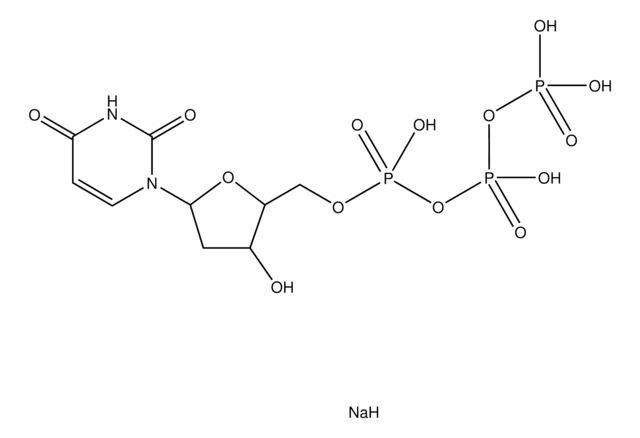Key Documents
DCTP-RO
Roche
dCTP
99% (dNTP), <0.9% (dNDP), solution, 100 mM
Synonim(y):
2′-Deoxycytidine 5′-triphosphate disodium salt, dCTP-Na2
About This Item
Polecane produkty
opis
PCR Grade, sodium salt
Poziom jakości
Próba
99% (dNTP)
Postać
solution
zastosowanie
sufficient for 125,000 standard reactions (03732690001)
sufficient for 31,250 standard reactions (11969021001)
sufficient for 6,250 standard reactions (11934520001)
opakowanie
pkg of 1,250 μL (11969021001 [100 mM])
pkg of 4 × 1,250 μL (03732690001 [4x100 mM])
pkg of 250 μL (11934520001 [100 mM])
producent / nazwa handlowa
Roche
stężenie
<0.9% (dNDP)
100 mM
temp. przechowywania
−20°C
ciąg SMILES
[Na+].[Na+].NC1=NC(=O)N(C=C1)[C@H]2C[C@H](O)[C@@H](COP(O)(=O)OP([O-])(=O)OP(O)([O-])=O)O2
InChI
1S/C9H16N3O13P3.2Na/c10-7-1-2-12(9(14)11-7)8-3-5(13)6(23-8)4-22-27(18,19)25-28(20,21)24-26(15,16)17;;/h1-2,5-6,8,13H,3-4H2,(H,18,19)(H,20,21)(H2,10,11,14)(H2,15,16,17);;/q;2*+1/p-2/t5-,6+,8+;;/m0../s1
Klucz InChI
ABWVCNMFYVEBIB-CDNBRZBRSA-L
Szukasz podobnych produktów? Odwiedź Przewodnik dotyczący porównywania produktów
Powiązane kategorie
Opis ogólny
Zastosowanie
Jakość
Postać fizyczna
Uwaga dotycząca przygotowania
Inne uwagi
Kod klasy składowania
12 - Non Combustible Liquids
Klasa zagrożenia wodnego (WGK)
WGK 1
Temperatura zapłonu (°F)
does not flash
Temperatura zapłonu (°C)
does not flash
Certyfikaty analizy (CoA)
Poszukaj Certyfikaty analizy (CoA), wpisując numer partii/serii produktów. Numery serii i partii można znaleźć na etykiecie produktu po słowach „seria” lub „partia”.
Masz już ten produkt?
Dokumenty związane z niedawno zakupionymi produktami zostały zamieszczone w Bibliotece dokumentów.
Klienci oglądali również te produkty
Nasz zespół naukowców ma doświadczenie we wszystkich obszarach badań, w tym w naukach przyrodniczych, materiałoznawstwie, syntezie chemicznej, chromatografii, analityce i wielu innych dziedzinach.
Skontaktuj się z zespołem ds. pomocy technicznej










